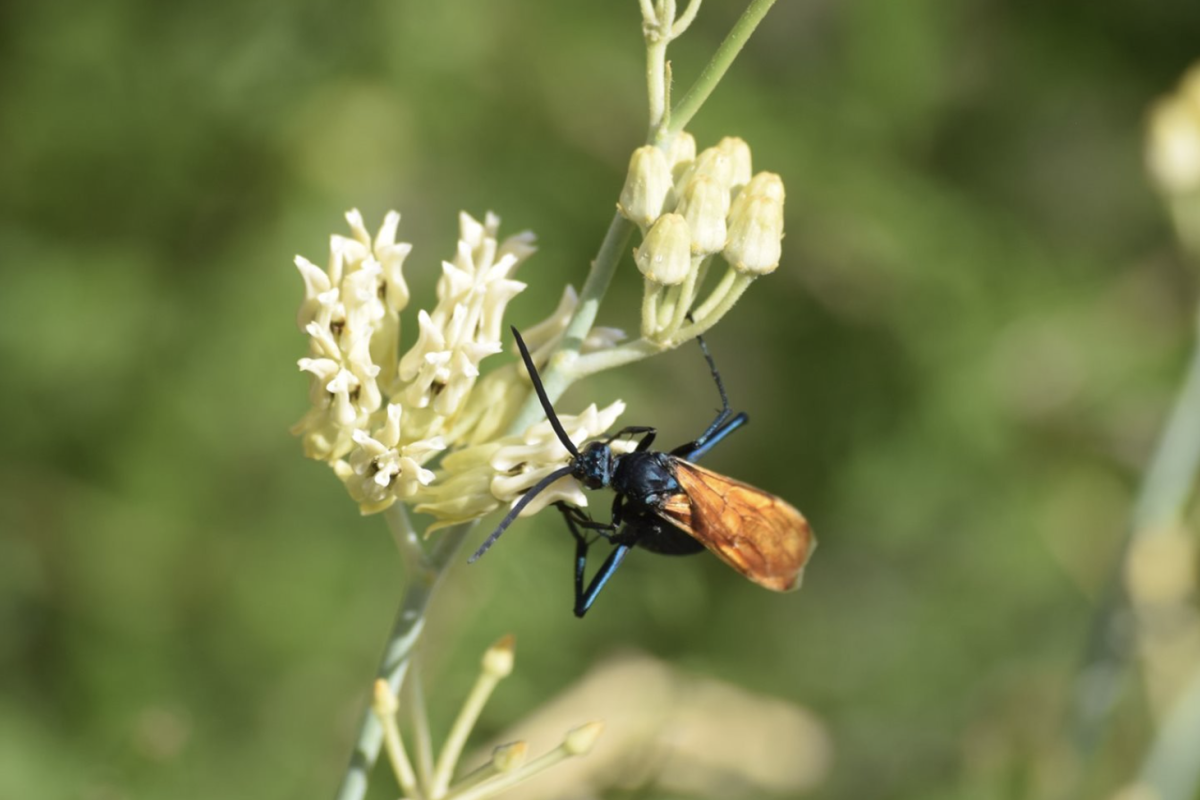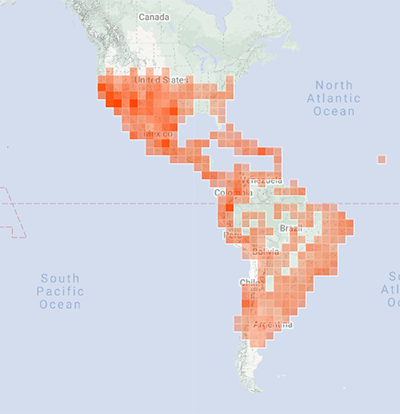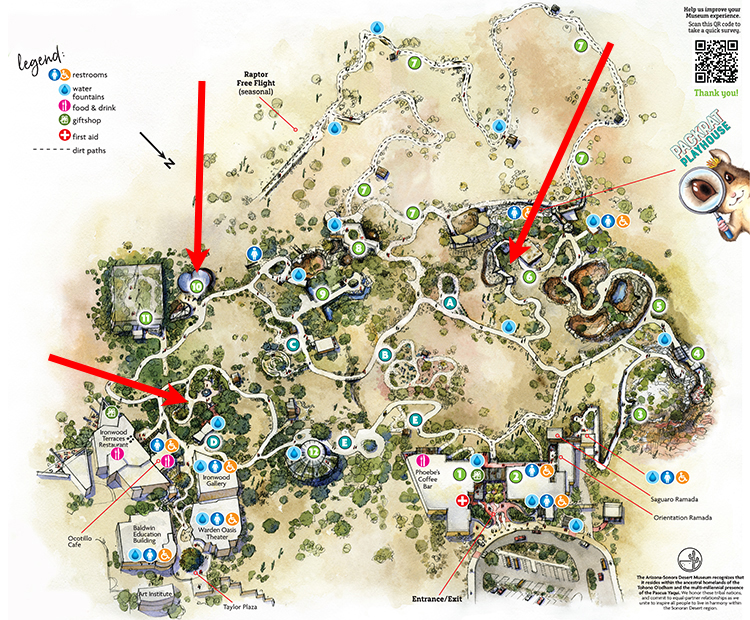Pepsis Wasp

About
It’s a bird! It’s a plane! It’s a… tarantula hawk! Tarantula hawks, also known as Pepsis wasps, are a genus with over 300 species of large parasitic wasps (and there are likely many more yet to be discovered!). Almost all are iridescent black, like a puddle of oil, with bright orange wings. And they’re big, with the largest being over 4 inches long (Pepsis heros). The most common species found in the Sonoran Desert, Pepsis grossa, can get up to 2 inches in length — with a ½ inch stinger.
Adaptations
Thanks to the combination of their bright orange wings and black bodies, Pepsis wasps are easy for other animals to recognize as a threat. This special adaptation is known as aposematic coloration. Pepsis wasps primarily use their stinger for laying eggs, so they rely on the communication from their coloration to keep them from having to get into fights at all. If provoked, the females will use their powerful stinger as a form of protection. Though typically non-lethal, the sting of the female tarantula hawk is consistently rated as one of the most painful insect stings in the world.
Food Web
Tarantula hawks get their name due to the important role that tarantulas play in their life cycle (See “Family Life” below). The body of a paralyzed tarantula serves as both a safe place for the wasp larva to grow and as its first meal. Once hatched, the wasp larva carefully eats its way through the spider’s abdomen while keeping the heart and nervous system intact. Eating around the vital organs keeps the meal fresh over the three weeks that it takes for the larva to mature into adulthood. Adult Pepsis wasps are nectarivorous, meaning they get most of their energy from pollen and nectar. As they eat, tarantula hawks serve as important pollinators for the plants that they visit. Their favorite flowers are milkweeds and mesquites, but different Pepsis species may enjoy different kinds of plants.
Due to their aposematic coloration (See “Adaptations”) most animals avoid risking that painful sting for a small meal. However, roadrunners and American bullfrogs are braver than most. Roadrunners will catch the wasp and slam it on the ground to break the stinger before swallowing. American bullfrogs (which are invasive to the Sonoran Desert) will simply eat just about anything that crawls in front of them.

Habitat and Range
Pepsis species can be found across the western hemisphere, from northern Utah down to central Argentina. It’s a safe bet to say that wherever you can find tarantulas, you can find tarantula hawks or their close relatives. The majority live in the tropics of South and Central America, but a handful of species (like Pepsis grossa) live in the deserts of the southwest.
iNaturalist records of Genus Pepsis as of March 21, 2024

Family Life
The interrelationship between Pepsis wasps and tarantulas is immortalized in the common name of this animal — tarantula hawks. In this parasitic relationship, Pepsis wasps serve as the parasite and tarantulas serve as host. Females will crawl along the ground to find a tarantula burrow, step on the trip-wire webbing, and cause the tarantula to come out of the burrow. Pepsis wasps are adapted to whip their abdomen underneath the spider to string as many times as needed to cause complete paralysis. The female then drags the paralyzed tarantula back into its burrow, lays a single egg on the spider’s abdomen, and backs out to seal the entrance. Within the burrow, the newly hatched larva consumes the tarantula and then wraps themselves in a silk cocoon and pupates into their adult form. Adult females live for about 5 months while adult males live for around 1-2 months.
Glossary
- Genus:
- A classification of organisms that is made based on common characteristics. Genus ranks above species and below family in taxonomic order.
- Parasitic:
- Benefitting from another organism at that organism’s expense.
- Aposematic coloration:
- Bright coloration of organisms that typically indicate danger to other organisms. (Also known as warning colors)
- Nectarivorous:
- having a diet that mostly consists of nectar and pollen.
- Pollinator:
- Anything that helps carry pollen from a flower’s stamen to the same or another flower’s stigma. This fertilizes the flower and allows it to grow into fruit/seeds.
- Invasive:
- A non-native organism that is introduced to an area causes harm to the ecosystem.
- Pupate:
- To transition from larva to pupa to the adult form.
- Batesian Mimicry:
- When a species copies the appearance of another organism without having the characteristics that make that organism undesirable (ex. non-venomous robber flies that are colored like tarantula hawks).
Fun Facts
- Male tarantula hawks cannot sting. Stingers are modified from egg-laying structures called ovipositors which only females have.
- After an encounter with the wasp’s intense sting, other organisms learn to recognize that coloration and avoid messing with it. This is so successful that Pepsis wasps have copycats! Many non-stinging insects like robber flies have evolved to look just like Pepsis wasps, so they can piggyback off the wasps’ hard-earned intimidation. This is known as Batesian mimicry.
- If no egg is laid on a captured tarantula, it can recover from the paralysis after several months!
- Unfertilized eggs become male, fertilized eggs become female, and the mother wasp can choose which one to have!
- The bigger the tarantula a Pepsis wasp was born on, the bigger the adult wasp will grow to be. Females will generally lay male eggs on male tarantulas and female eggs on the larger female tarantulas, since females wasps need to grow to be big and strong to hunt tarantulas themselves one day.
- There is a closely related genus called Hemipepsis found all over the world that is also called tarantula hawk for their similar parenting styles.
Conservation
Pepsis wasp populations are stable and not considered endangered.
At The Museum
View on Map

- Keep an eye out as you explore! Adults can be seen flying through grounds or peacefully visiting milkweeds in the Pollinator Garden.
- In the summer, wild Pepsis wasps can be observed feeding on nectar and looking for mates in a large crucifixion tree near the entrance to the Stingray Touch exhibit.
- Other favorite spots are the western soapberry trees in the Desert Grasslands and Desert Gardens areas.










